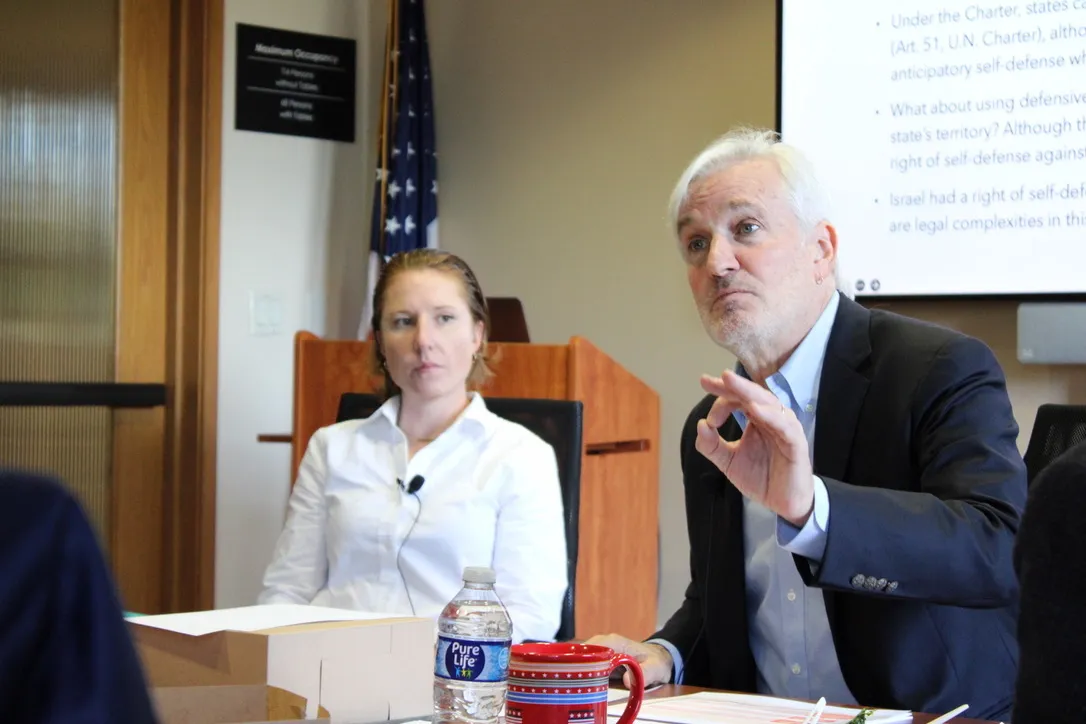Israel’s actions since the Oct. 7, 2023 Hamas attacks have been unwarranted and extreme, argued Bailey Ulbricht, executive director of the Stanford Humanitarian Program, and Allen Weiner, Stanford Law School senior lecturer, in a Tuesday talk sponsored by the Center for International Security and Cooperation (CISAC).
Forty attendees, mostly graduate students and fellows, crowded into the William J. Perry conference room in Encina Hall to hear the talk. Weiner and Ulbricht spoke alongside Corey Scher, doctoral candidate in Earth and environmental sciences at the City University of New York, and Jamon Van Den Hoek, associate professor of geography at Oregon State University.
“It was foreseeable on Oct. 8 that Israel could not in fact carry out [its] presumptively permissible war aims of removing Hamas from power and destroying its military capability without causing excessive harm,” Weiner said. “We are not the only people who had this view.”
The two sides remain at war today, more than 13 months after Hamas’ attack and Israel’s retaliation. Vigorous debate over the conflict has swept the United States — including its college campuses — since Oct. 7. Last year, Stanford’s campus saw protests, counter-protests and a 120-day pro-Palestine sit-in in White Plaza.
Weiner and Ulbricht turned attendees’ attention to a lesser-discussed element of the war: jus ad bellum — a well-established tenet of international law.
Their talk was motivated by what they perceived to be a lack of attention to the proportionality principle in widespread debates over the Israel-Hamas war. Jus ad bellum, translated from Latin as the “right to war,” is a pillar of war theory, governing “when states may use force in their international relations,” Weiner said.
As a test that analyzes states’ war aims and their actions in war, jus ad bellum enables lawyers to assess whether a state has the right to use force.
Ulbricht and Weiner said that Israel had the right to self-defense under the UN Charter’s Article 51 and that their war aim — to remove Hamas — was “presumptively legitimate.”
“Oct. 7 was not a one-off attack,” Weiner said. “There is a tangible threat of future attacks from Hamas.”
However, Weiner said, Israel “should have known on Oct. 8” that it would be unable to achieve its goal of removing Hamas from political power and disarming its military capability “without causing excessive harm.”
Scher and Jamon Van Den Hoek, experts in geography and earth sciences, displayed data they collected on destruction in Gaza since the war began. Using coherent change detection, a method of gathering data from satellite radar images, the two found that 60% of all buildings in Palestinian territory have been destroyed or damaged since the start of the war.
Referring to an animated graph mapping the damage done in Gaza since the start of the war, Van Den Hoek said that Israel rapidly inflicted damage in North Gaza during the first three weeks of the war.
“You can see that the boundaries of the Gaza strip are basically delineated by the extent of damage,” Van Den Hoek said. “That’s how severe it is.”
Ulbricht compared the damage in Gaza to damage in Ukraine to demonstrate the disproportionality of Israel’s actions in Gaza. In the first six weeks of the war, 88% of health facilities and 70% of water facilities in North Gaza were damaged, compared to 10% of health facilities damaged in Ukraine after a year of war with Russia.
The “excessive” damage in Gaza is an indicator that Israel has violated jus ad bellum proportionality, Ulbricht and Weiner said. Ulbricht added that although “war is inherently destructive,” damage in Gaza is “clustered around civilian infrastructure.”
Gina Sinclair, a research assistant at CISAC who attended the talk, said she thought Scher and Van Den Hoek’s “integration of satellite imagery analysis” was “really interesting” for visualizing “the scale and timeline of destruction in the conflict.”
Ulbricht and Weiner said they did not know where to draw the line for damage that constitutes a violation of jus ad bellum proportionality, but Weiner said it was “clear that [Israel’s] operations have crossed it.” He added that Israel’s use of force caused “extensive civilian harm,” while Ulbricht said Israel had “other legitimate options,” including destroying Hamas’s weapons depots and launching targeted strikes to kill Hamas’s key military operatives.
Humzah Khan M.S. ’26, a student in international policy, said the talk was “an interesting legal analysis.” Yet, Khan said he was “not convinced how international law really matters.”
“States can break international law all the time and not much really happens,” Khan said.
Weiner said Israel, despite being a member of the United Nations, was “simply in violation of international law.”
“Israel has no capacity to dissent or excuse itself from obligations,” Weiner said.
